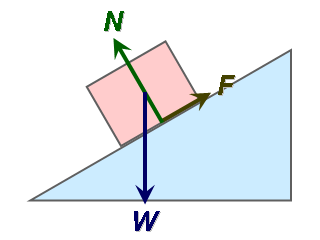
Knowledge and Skills Statement
The further explanation is designed to be a resource for educators that helps them better understand the topic their students are learning. Further explanations may be written at a more complex level than would be expected for students at the grade level.
A free-body diagram of a block resting on a rough inclined plane, with its weight (W), normal force (N), and friction (F) shown.
SlaveOfExam at English Wikipedia, Public domain, via Wikimedia Commons
Research
Mešic, Vanes, Sabaheta Mahmutovic, Elvedin Hasovic, and Nataša Erceg. "Free-Body Diagrams and Problem Solving in Mechanics: An Example of the Effectiveness of Self-Constructed Representations." European Journal of Physics Education 7, no. 3 (2016): 53-67.https://eu-journal.org/index.php/EJPE/article/view/147
Summary: One type of representation that is particularly important for teaching mechanics is the free-body diagram. In this study, we investigated how the inclusion of free-body diagrams into problem statements influences students' performance in solving mechanics problems. It was found that the inclusion of free-body diagrams into the problem statements not only did not facilitate problem-solving, but also impeded it significantly.
Research
Coelho, R. Lopes. "On the Deduction of Newton’s Second Law." Acta Mechanica 229, no. 5 (2018): 2287-2290. https://doi.org/10.1007/s00707-017-2074-2
Summary: The present paper's task is to compare Newton’s second law and Euler’s principle and verify whether there are significant differences between them. The result is that Newton’s axiomatic system and technique of decomposing force differ from Euler’s.

